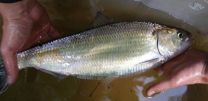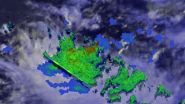(Press-News.org) A new way of measuring sea level using satellite navigation system signals, for instance GPS, has been implemented by scientists at Chalmers University of Technology in Sweden. Sea level and its variation can easily be monitored using existing coastal GPS stations, the scientists have shown.
Measuring sea level is an increasingly important part of climate research, and a rising mean sea level is one of the most tangible consequences of climate change. Researchers at Chalmers University of Technology have studied new ways of measuring sea level that could become important tools for testing climate models and for investigating how the sea level along the world's coasts is affected by climate change.
Johan Löfgren and Rüdiger Haas, scientists at Chalmers Department of Earth and Space Sciences, have developed and tested an instrument that measures the sea level using radio signals from satellite navigation systems: a GNSS tide gauge (GNSS stands for Global Navigation Satellite System).
"The global mean sea level is rising because of climate change, but the change depends on where you are in the world", says Rüdiger Haas. "We want to be able to make detailed measurements of sea level so that we can understand how coastal societies will be affected in the future."
The GNSS tide gauge uses radio signals from satellites in orbit around the Earth that are part of satellite navigation systems like GPS and Glonass (Russia's equivalent of GPS).
"We measure the sea level using the same radio signals that mobile phones and cars use in their satellite navigation systems", says Johan Löfgren. "As the satellites pass over the sky, the instrument 'sees' their signals – both those that come direct and those that are reflected off the sea surface."
Two antennas, covered by small white radomes, measure signals both directly from the satellites and signals reflected off the sea surface. By analyzing these signals together, the sea level and its variation can be measured, up to 20 times per second. The sea level time series is rich in physical phenomena such as tides (caused mostly by the gravitational pull of the Moon and the Sun), meteorological signals (high and low pressure), and signals from climate change. Through advanced signal processing, these signals can be studied further.
The new GNSS tide gauge has the advantage that it can measure changes in both land and sea at the same time, in the same location. That means that both long-term and short-term land movements (post-glacial rebound and earthquakes) can be taken into consideration.
"Now we can measure the sea level both relative to the coast and relative to the centre of the Earth, which means we can clearly tell the difference between changes in the water level and changes in the land", says Johan Löfgren.
This summer the tide gauge station at Onsala Space Observatory will be complemented, in collaboration with SMHI, the Swedish Meteorological and Hydrological Institute. Other high-precision instruments will be installed to work together with the GNSS tide gauge.
"Our tide gauge station will become part of a network of stations along the coast of Sweden that will be able to monitor changes in the water level to millimetre precision well into the future", says Gunnar Elgered, professor at Chalmers Department of Earth and Space Sciences.
The scientists have also shown that existing coastal GNSS stations, installed primarily for the purpose of measuring land movements, can be used to make sea level measurements.
"We've successfully tested a method where only one of the antennas is used to receive the radio signals. That means that existing coastal GNSS stations – there are hundreds of them all over the world – can also be used to measure the sea level", says Johan Löfgren.
INFORMATION: END
New tide gauge uses GPS signals to measure sea level change
2014-05-21
ELSE PRESS RELEASES FROM THIS DATE:
Dam removal improves shad spawning grounds, may boost survival rate
2014-05-21
Research from North Carolina State University finds that dam removal improves spawning grounds for American shad and seems likely to improve survival rates for adult fish, juveniles and eggs – but for different reasons.
The researchers focused on a small tributary in North Carolina called the Little River, where three dams were removed in the late 1990s and early 2000s. American shad (Alosa sapidissima) spend the bulk of their adult lives in saltwater, but return to freshwater rivers like this one to spawn. While in these freshwater environments, the adult shad do not ...
Breakthrough: Nasal spray may soon replace the pill
2014-05-21
Every time we have an infection or a headache and take a pill, we get a lot more drugs than our body actually needs. The reason is that only a fraction of the drugs in a pill reaches the right places in the body; the rest never reaches its destination and may cause unwelcome side effects before they are flushed out of the body again. This kind of major overdosing is especially true when doctors treat brain diseases, because the brain does not easily accept entering drugs.
"People with brain diseases are often given huge amounts of unnecessary drugs. During a long life, ...
Seeing is a matter of experience
2014-05-21
The headlights – two eyes, the radiator cowling – a smiling mouth: This is how our brain sometimes creates a face out of a car front. The same happens with other objects: in house facades, trees or stones – a "human face" can often be detected as well. Prof. Dr. Gyula Kovács from Friedrich Schiller University Jena (Germany) knows the reason why. "Faces are of tremendous importance for human beings," the neuroscientist explains. That's why in the course of the evolution our visual perception has specialized in the recognition of faces in particular. "This sometimes even ...
Cyberbullying affects rich and poor alike
2014-05-21
EAST LANSING, Mich. --- Cyberbullying isn't just a problem in middle class and affluent areas. Teenagers in poor, high-crime neighborhoods also experience online bullying, finds new research led by a Michigan State University criminologist.
The study suggests the "digital divide" – the gap between people with access to online technologies and those without – may be nonexistent, at least when it comes to cyberbullying, said Thomas J. Holt, MSU associate professor of criminal justice.
"We found neighborhood conditions that are indicative of poverty and crime are a significant ...
NASA sees developing tropical cyclone in Bay of Bengal
2014-05-21
VIDEO:
In this TRMM 3-D simulated flyby of System 92B from May 19, tall storms were shown reaching heights of over 14km (about 8.7 miles).
Click here for more information.
A tropical low pressure area known as System 92B has been organizing in the Northern Indian Ocean's Bay of Bengal and NASA's TRMM satellite has shown strong thunderstorms and heavy rainfall in the developing storm.
The Tropical Rainfall Measuring Mission or TRMM satellite passed over System 92B on May 19 and ...
Shared custody is becoming the norm
2014-05-21
It's no longer a certainty that American mothers will get custody over their children during a divorce. In fact, if Wisconsin Court Records of the past 20 years are anything to go by, joint custody is becoming the norm. So says Maria Cancian and colleagues from the University of Wisconsin–Madison in the US, whose findings are published in Springer's journal Demography.
For most of the twentieth century, in both divorce and nonmarital cases, most children ended up living with their mothers after their parents' divorce. This conformed to gender norms that views mothers ...
Functional nerve cells from skin cells
2014-05-21
A new method of generating mature nerve cells from skin cells could greatly enhance understanding of neurodegenerative diseases, and could accelerate the development of new drugs and stem cell-based regenerative medicine.
The nerve cells generated by this new method show the same functional characteristics as the mature cells found in the body, making them much better models for the study of age-related diseases such as Parkinson's and Alzheimer's, and for the testing of new drugs.
Eventually, the technique could also be used to generate mature nerve cells for transplantation ...
Low IQ students learn to read at 1st-grade level after persistent, intensive instruction
2014-05-21
VIDEO:
Children identified as intellectually disabled or with low IQ learned to read at a first-grade level after persistent, intensive instruction from a scientifically based curriculum. The findings of the pioneering...
Click here for more information.
The findings of a pioneering four-year educational study offer hope for thousands of children identified with intellectual disability or low IQ who have very little, if any, reading ability.
The study by researchers at Southern ...
On the road to improvement: EPA's troubled program on chemical hazards
2014-05-21
Out of the thousands of chemicals used for countless everyday products, about 500 have been assessed for potential health risks by the federal program tasked with this colossal duty. The good news is the Environmental Protection Agency, which runs the program, has improved it, but more remains to be done, according to a report from the National Research Council (NRC). Chemical & Engineering News (C&EN), the weekly news magazine of the American Chemical Society, hits the report's highlights.
Cheryl Hogue, senior correspondent for C&EN, explains that the EPA program, called ...
A new solution for storing hydrogen fuel for alternative energy
2014-05-21
Turning the "hydrogen economy" concept into a reality, even on a small scale, has been a bumpy road, but scientists are developing a novel way to store hydrogen to smooth out the long-awaited transition away from fossil fuels. Their report on a new solid, stable material that can pack in a large amount of hydrogen that can be used as a fuel appears in the ACS journal Chemistry of Materials.
Umit B. Demirci and colleagues explain that storing hydrogen in solids is a recent development and a promising step toward building a hydrogen economy. That's the idea originated ...







